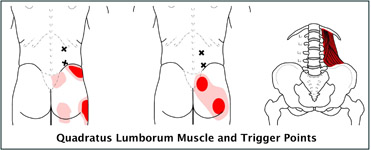This is Part 2 of a case study. If you missed the beginning, go back to the previous entry.
Sidney K. responded well to two Neuromuscular Therapy sessions on the muscles of her low back and buttock in my treatment center near Boston. In the third treatment with her body calmer, emerged what I am calling “Low back and butt syndrome.” The syndrome is similar to whiplash in the neck where symptoms in the butt emerge slowly from an initiating event in the back. For Sidney it was the child jumping on her left shoulder. To stabilize her back, her body automatically protected her by a sudden contraction of all of the low back and butt muscles, the ones that are essential to maintain upright posture. Over time, without appropriate specific treatment of the muscles, they got tighter and tighter until they developed local areas of pain and dysfunction and then Trigger Points that referred pain elsewhere.

 The lower lumbar paraspinals on each side of the spine, both superficial (< left) and deep (> right), that kept her upright in the event developed local pain and then referrals from Trigger Points into the butt and sacroiliac (SI) joint. The quadratus lumborum (QL) muscle (see below) that protected her side-bending muscles in the one-sided pull started referring into her butt and hip.
The lower lumbar paraspinals on each side of the spine, both superficial (< left) and deep (> right), that kept her upright in the event developed local pain and then referrals from Trigger Points into the butt and sacroiliac (SI) joint. The quadratus lumborum (QL) muscle (see below) that protected her side-bending muscles in the one-sided pull started referring into her butt and hip.
Furthermore, her hip flexor muscles had grabbed to keep her stable in her seated position during both the initiating event and the previous auto accident and were now causing groin pain. The auto accident, as with whiplash, had also affected both her neck and back muscles (remember that she felt pain first in her neck and only later in her back). The accident was most likely the original injury since it preceded the event with the child by one year and was never effectively treated.
So what happens in cases like these is that injured muscles develop Trigger Points that shoot pain to their referral zones, in this case the butt. The continued irritation of the referred pain causes local inflammation of the muscles in the referral zone. They in turn develop their own dysfunction and Trigger Points that refer to the next zone, feeling like the pain is spreading (called Myofascial Pain Syndrome). A more accurate image is like a relay race, where the baton gets passed to the next team member.
 For Sidney, the main problem came from her lower lumbar paraspinals and QL. Referrals went into her glutes and piriformis causing tension in the SI joint and entrapment of the sciatic nerve. When she came to me, her piriformis muscle was in spasm and all the muscles in her low back, butt and groin were tight and becoming dysfunctional.
For Sidney, the main problem came from her lower lumbar paraspinals and QL. Referrals went into her glutes and piriformis causing tension in the SI joint and entrapment of the sciatic nerve. When she came to me, her piriformis muscle was in spasm and all the muscles in her low back, butt and groin were tight and becoming dysfunctional.
To treat this syndrome, I start with the lumbar paraspinals, local ligaments and QL. Next come the glut max and piriformis and third are the assisting and accessory muscles, glut min and med and all the hip flexors and groin muscles.
This has been a really wonderful article.
Many thanks for providing this info.
Helpful